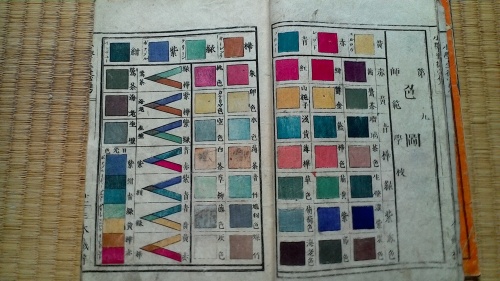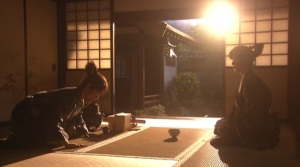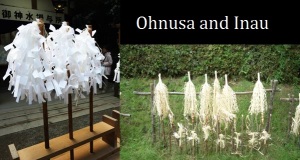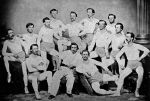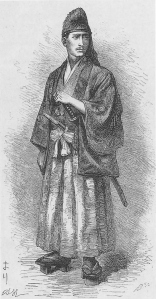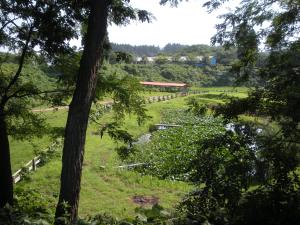
Horse Pasture at Towada Riding Club
This year was my first time to attend the Towada Yabusame Clinic. To be honest, it seemed aimed at people a bit better at Yabusame than myself, but I was still able to learn a lot. The clinic was divided into two days. The first day (Saturday) was the lecture session, held at the local community center. Over 60 people attended the lectures, but not all of them were active Yabusame practitioners. I imagine some of them were just interested in Japanese history while I suspect others, based on the elaborate drawings in their notebooks, were artists who wanted to learn how to correctly draw samurai on horseback.
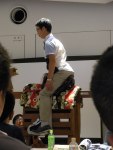
The right way to ride during Yabusame
The first lecture was called “About the Taming and Training of Young Horses”. You can basically gather its contents from the title, but in particular, the lecturer hoped to explain how horses can be trained so that they can be ridden by anyone, not only the owner. If this is done, then it will be much easier for people to get interested and try out horseback riding and yabusame. I like horses, and I love yabusame, so I want to learn how to ride a horse and how to basically care for a horse. However, I wouldn’t say I am a horse person, that is someone who makes horses his life. I think it is pretty unlikely I will ever be in the position of seriously trying to train a horse. Despite this, the lecture was interesting. In particular, I was struck by the thought that training is a lot like teaching children, the main difference being that children can eventually learn to use language, while horses cannot.
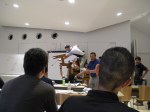
Yabusame!
The second lecture was called “A Mede Vacum to a Safer, More Accurate Enjoyable Yabusame”. You may have noticed by now that Japanese lecturers prefer long names to their lectures and articles. Anyway, I should give a little context about Yabusame before explaining this lecture: Yabusame is historical Japanese horseback archery. But I should put the emphasis on historical Japanese. Recently, a lot of people having been using the term “yabusame” to refer to any sort of horseback archery, but that is just incorrect. With the aim of preserving the historical tradition of Yabusame accurately while allowing it to be accessible to all types of people, a lot of people have been working to form an umbrella sort of organization that sets basic standards for Yabusame. Thus this lecture was explaining what Yabusame is (and is not) and how we can practice Yabusame with historical accuracy.
The lecture divided horseback archery into three categories:
- Shinji Yabusame: Yabusame demonstrations at shrines. Usually, Japanese saddles and other equipment is used, but the type of horse is unrestricted. Usually, only men can take part.
- Kyougi Yabusame: Yabusame competitions. Japanese saddles and other equipment is used. Japanese breeds of horses are used. Women, children, and foreigners can participate and safety is placed at a premium.
- Horseback Archery: Competitions involving archery from horseback. It can include horseback archery traditions from other countries as well.
In short, Yabusame is the reenactment of Japanese historical horseback archery and only that. The nature of yabusame being clarified, the lecture went into a lot of details about how to ride and shoot on Japanese equipment, based on both actual experience and historical manuals and illustrations. It is a bit difficult to explain using only words (the lecturer brought a wooden horse with him and had his students show us on that), but rather than sort of standing from the stirrups, one should have your feet forward almost in a hachi (八) shape, with the rear-end just resting on the top back of the saddle. The breast is thrown forward, but the back is almost arched so you don’t looked hunched over at all. The legs are in a bent position and my impression was that the knees can be more easily used to control the horse in this case. This position is collaborated by both pictures and written manuals. Furthermore, this position is a lot safer than standing up or leaning forward in the saddle as is sometimes seen done by Yabusame practitioners. I suppose that isn’t surprising that this historical position is safer, since falling off your horse probably had severe consequences (ie: death) for samurai than it does in modern times.
There was a lot more to the lecture than this, but that was the basic gist. After the lectures there was a sort of test, but since it is difficult for me to read and write Japanese quickly, I couldn’t finish it in the 10 minutes they gave us… 😦 That evening everyone went to dinner together at a Japanese yakiniku (grilled meat) place. It was good opportunity to meet everyone and chat, but I was really tired having gotten up at 4 in morning and a bit suffocated by all the smoke and the stench of meat, so my friends and I left early to take a bath at the bathhouse and then go to bed early.
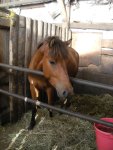
Ninta (Kageryuu)
The second day (Sunday) was the “practicum” of yabusame. Those who participated in the practicum were less than 30 people, I think. The day was blazing hot (over 30 degrees) and we all felt like melting, but could still enjoy our time. Each horse was assigned two people. My horse, Kageryuu AKA Ninta, was the son of my friend’s horse in Hokkaido who was recently sold to Towada Horse Club. So not only was Kageryuu a dosanko horse which is what I am used to riding, but I had even ridden Kageryuu before in Hokkaido. My partner was also one of my friends, which was nice because I felt less embarrassed about asking her questions.

Me, failing at Yabusame
We first combed down the horses, saddled them, and took them up to the teppou baba (yabusame runway). Then we alternated trying to shoot at the targets while the horse was walking. This was not difficult. We then basically tried the same thing several times keeping the horses as a canter or run. I basically failed miserably at this, but it was learning experience. By this time, it was nearly noon and everyone was extremely hot and sweaty, so we breaked for lunch.
After lunch, about 10 of the people were asked to practice yabusame using proper Japanese saddle and stirrups. The teachers then marked them in a sort of mock exam. I was a little bit sad about not getting to try to use a Japanese style saddle, but I was happy to overhear some of the teachers saying that one of my friends was the best looking of everybody using the Japanese saddle. By the way, the saddle used was a gunjin-kura (軍陣鞍 military saddle), as opposed to the more common shikan-kura (士官鞍 officials saddle). It is a bit wider and apparently more comfortable than the saddle more commonly seen.
After that, the clinic came to a close. Many people stayed another night, but I had to catch the overnight ferry back that day in order to be back in Sapporo for work on Monday. It was a really nice trip, not only to learn about Yabusame, but also spending time with my friends and meeting many people who love Yabusame. I could chat with a lot of people about Hawaii and the Yabusame Joshi-bu (Girl’s Club) said I could the President of the club’s Hawaii Chapter. Of course, I am pretty sure I am only person from Hawaii in the club, so that doesn’t really say much…. However, if you love yabusame you can become a supporter!
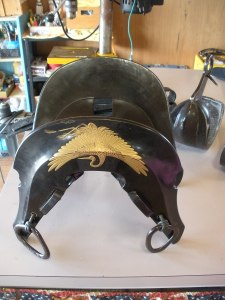
The beautiful Gunjin-kura saddle
Read Full Post »
